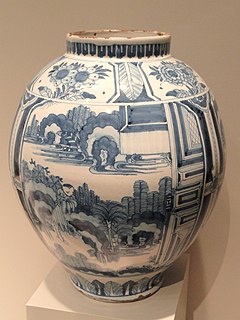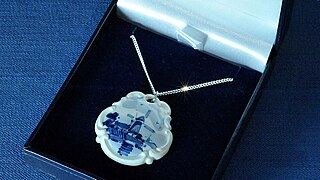
Delft is a city and municipality in the province of South Holland, Netherlands. It is located between Rotterdam, to the southeast, and The Hague, to the northwest. Together with them, it is part of both the Rotterdam–The Hague metropolitan area and the Randstad.

South Holland is a province of the Netherlands with a population of over 3.7 million as of October 2021 and a population density of about 1,373/km2 (3,560/sq mi), making it the country's most populous province and one of the world's most densely populated areas. Situated on the North Sea in the west of the Netherlands, South Holland covers an area of 3,307 km2 (1,277 sq mi), of which 607 km2 (234 sq mi) is water. It borders North Holland to the north, Utrecht and Gelderland to the east, and North Brabant and Zeeland to the south. The provincial capital is the Dutch seat of government The Hague, while its largest city is Rotterdam. The Rhine-Meuse-Scheldt delta drains through South Holland into the North Sea. Europe's busiest seaport, the Port of Rotterdam, is located in South Holland.

Delftware or Delft pottery, also known as Delft Blue or as delf, is a general term now used for Dutch tin-glazed earthenware, a form of faience. Most of it is blue and white pottery, and the city of Delft in the Netherlands was the major centre of production, but the term covers wares with other colours, and made elsewhere. It is also used for similar pottery, English delftware.

Gouda is a city and municipality in the west of the Netherlands, between Rotterdam and Utrecht, in the province of South Holland. Gouda has a population of 75,000 and is famous for its Gouda cheese, stroopwafels, many grachten, smoking pipes, and its 15th-century city hall. Its array of historic churches and other buildings makes it a very popular day trip destination.

Schoonhoven is a city and former municipality in the western Netherlands, in the province of South Holland. Since 2015 it has been a part of the municipality of Krimpenerwaard, before it had been an independent municipality.

Faience or faïence is the general English language term for fine tin-glazed pottery. The invention of a white pottery glaze suitable for painted decoration, by the addition of an oxide of tin to the slip of a lead glaze, was a major advance in the history of pottery. The invention seems to have been made in Iran or the Middle East before the ninth century. A kiln capable of producing temperatures exceeding 1,000 °C (1,830 °F) was required to achieve this result, the result of millennia of refined pottery-making traditions. The term is now used for a wide variety of pottery from several parts of the world, including many types of European painted wares, often produced as cheaper versions of porcelain styles.

The Koninklijke Porceleyne Fles N.V. is a Dutch manufacturer of Delft Blue earthenware, headquartered in Delft, the Netherlands. It is the only remaining factory out of 32 that were established in Delft during the 17th century. Today, the company has been active for over 360 years without interruption.

Tin-glazed pottery is earthenware covered in lead glaze with added tin oxide which is white, shiny and opaque ; usually this provides a background for brightly painted decoration. It has been important in Islamic and European pottery, but very little used in East Asia. The pottery body is usually made of red or buff-colored earthenware and the white glaze imitated Chinese porcelain. The decoration on tin-glazed pottery is usually applied to the unfired glaze surface by brush with metallic oxides, commonly cobalt oxide, copper oxide, iron oxide, manganese dioxide and antimony oxide. The makers of Italian tin-glazed pottery from the late Renaissance blended oxides to produce detailed and realistic polychrome paintings.

The Roman Catholic Diocese of Rotterdam is a Latin diocese of the Catholic Church in South Holland province of the Netherlands. The diocese is a suffragan in the ecclesiastical province of the Metropolitan Archbishop of Utrecht. Since 2011, the bishop has been Hans van den Hende.

The current Crown of the Netherlands is of relatively modern origin. In 1813 the new "Sovereign Ruler" of the Netherlands, Prince Willem of Orange, son and heir of the exiled Stadtholder Willem V of Orange, was sworn in as Dutch monarch in Amsterdam. There was no crown present at the ceremony.

Art pottery is a term for pottery with artistic aspirations, made in relatively small quantities, mostly between about 1870 and 1930. Typically, sets of the usual tableware items are excluded from the term; instead the objects produced are mostly decorative vessels such as vases, jugs, bowls and the like which are sold singly. The term originated in the later 19th century, and is usually used only for pottery produced from that period onwards. It tends to be used for ceramics produced in factory conditions, but in relatively small quantities, using skilled workers, with at the least close supervision by a designer or some sort of artistic director. Studio pottery is a step up, supposed to be produced in even smaller quantities, with the hands-on participation of an artist-potter, who often performs all or most of the production stages. But the use of both terms can be elastic. Ceramic art is often a much wider term, covering all pottery that comes within the scope of art history, but "ceramic artist" is often used for hands-on artist potters in studio pottery.
Het geheim van Delft is a 1917 Dutch silent drama film directed by Maurits Binger. Most of the filming took place in Haarlem, and not in Delft.

The Princessehof Ceramics Museum is a museum of ceramics in the city of Leeuwarden in the Netherlands. The museum's name comes from one of two buildings in which it is housed: a small palace built in 1693 and later occupied by Marie Louise, dowager Princess of Orange. The other annexed building is the Papinga stins, a former stronghold from the 15th century. The museum buildings are of interest, and so are its collection of tiles, pottery, and ceramic sculpture.
Ib Georg Jensen was a Danish ceramist, designer and author by the alias 'Muk'.

Johannes Jacobus (Jan) van der Vaart was an influential Dutch ceramist from the 20th century, known as founder of the abstract-geometric ceramics in the Netherlands.

Cornelis (Cor) Dam was a Dutch artist, who has been active as sculptor, painter, illustrator and ceramist.

Henk Trumpie was a Dutch ceramist and sculptor.

Johanna Jacoba (Johnny) Rolf is a Dutch ceramist, drawing artist and sculptor.

Cornelis Verwoerd was a Dutch Delftware painter, modeler, and ceramist.
Willem Jansz Verstraeten was a Dutch Golden Age tin-glazed maiolica maker in Haarlem.






















